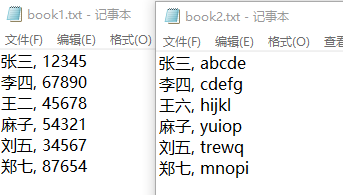How Python operates on file directories
Overview
I/O operations include not only screen input and output, but also file reading and writing. Python provides many necessary methods and functions for file and folder related operations. This article mainly uses two simple small examples to briefly describe the application of Python in folders and files, which are only for learning and sharing. If there are any deficiencies, please correct me.
Involving knowledge points
os module: The os module provides a very rich method for handling files and directories.
Open method: The open method is used to open a file for reading and writing.
Example 1: Get all the file sizes in the specified directory, and find the largest file and smallest file
**Decomposition steps: **
Traverse all sub-files and sub-folders under the folder (recursion is required), and calculate the size of each file
Calculate the total size of all files
Find the largest file and the smallest file
Core code
Define a method get_file_size to obtain the size of a single file in two units: KB and MB. The key points are as follows:
- os.path.getsize is used to get the size of the specified file, the unit is Byte.
- round is a rounding function, keeping the specified number of decimals.
def get_file_size(file_path, KB=False, MB=False):"""Get file size"""
size = os.path.getsize(file_path)if KB:
size =round(size /1024,2)
elif MB:
size =round(size /1024*1024,2)else:
size = size
return size
Define a method list_files to traverse the specified file directory and store it in the dictionary. The key points are as follows:
- os.path.isfile is used to determine whether the given path is a file or a folder.
- os.listdir is used to get all the files and folders in the specified directory and return a list, but only the name of the current folder, not the full path.
- os.path.join is used to join two paths
def list_files(root_dir):"""Iterate over files"""if os.path.isfile(root_dir): #If it is a file
size =get_file_size(root_dir, KB=True)
file_dict[root_dir]= size
else:
# If it is a folder, traverse
for f in os.listdir(root_dir):
# Splicing path
file_path = os.path.join(root_dir, f)if os.path.isfile(file_path):
# If it is a file
size =get_file_size(file_path, KB=True)
file_dict[file_path]= size
else:list_files(file_path)
Calculate the total size and the largest and smallest files as shown below:
By comparing the size of the dictionary value, the name of the corresponding key is returned. The key points are as follows:
- max_file = max(file_dict, key=lambda x: file_dict[x])
- min_file = min(file_dict, key=lambda x: file_dict[x])
if __name__ =='__main__':list_files(root_dir)
# print(len(file_dict))
# Calculate file directory size
total_size =0
# Traverse the key of the dictionary
for file in file_dict:
total_size += file_dict[file]print('total size is : %.2f'% total_size)
# Find the largest and smallest files
max_file =max(file_dict, key=lambda x: file_dict[x])
min_file =min(file_dict, key=lambda x: file_dict[x])print('max file is : ', max_file,'\n file size is :', file_dict[max_file])print('min file is : ', min_file,'\n file size is :', file_dict[min_file])
Example 2: Combine the contents of two text files and save them in the file
The contents of the two files are as shown in the following figure:

**Decomposition steps: **
- Read the contents of the two files and parse them to get the key and value, and store them in the dictionary (two dictionaries, respectively store the contents of the two files).
- Traverse the first dictionary and find the value of the same key in the second dictionary. If it does not exist, only the first content will be displayed. If it exists, it will be merged.
- Traverse the second dictionary and find the value of the key that is not in the first dictionary, and accumulate it.
- Save the spliced list into the file.
Core code
Define a function read_book to read the contents of two files. The key points are as follows:
- The open function is used to open a file, and the file encoding is UTF-8.
- readlines is used to read all the lines and return a list.
- split is used to split a string into an array.
def read_book():"""Read content"""
# Read a file
file1 =open('book1.txt','r', encoding='UTF-8')
lines1 = file1.readlines()
file1.close()for line in lines1:
line = line.strip() #Go blank
content = line.split(',')
book1[content[0]]= content[1]
# Another way, read another file,No need to close, it will close automatically
withopen('book2.txt','r', encoding='UTF-8')as file2:
lines2 = file2.readlines()for line in lines2:
line = line.strip() #Go blank
content = line.split(',')
book2[content[0]]= content[1]
Define a function to merge content and save it. The key points are as follows:
- append is used to add new elements to an array.
- The dict.keys function is used to return all keys.
- The join function is used to convert an array into a string and divide it by corresponding characters.
- writelines is used to write all lines to the file.
- With syntax, when the execution ends, it will automatically close and release resources.
def merge_book():"""Merge content"""
lines =[] #Define an empty list
header ='Name\t phone\t text\n'
lines.append(header)
# Traverse the first dictionary
for key in book1:
line =''if key in book2.keys():
line = line +'\t'.join([key, book1[key], book2[key]])
line +='\n'else:
line = line +'\t'.join([key, book1[key],' *****'])
line +='\n'
lines.append(line)
# Traverse the second one, and write that is not included in the first one
for key in book2:
line =''if key not in book1.keys():
line = line +'\t'.join([key,' *****', book2[key]])
line +='\n'
lines.append(line)
# Write to book3
withopen('book3.txt','w', encoding='UTF-8')as f:
f.writelines(lines)
The overall call is as follows:
if __name__ =='__main__':
# Read content
read_book()
# Merge content
merge_book()
# print(book1)
# print(book2)
The file generated after the last splicing is as follows:

Through the above two examples, you can roughly understand some methods and steps of file and directory operations.
Recommended Posts